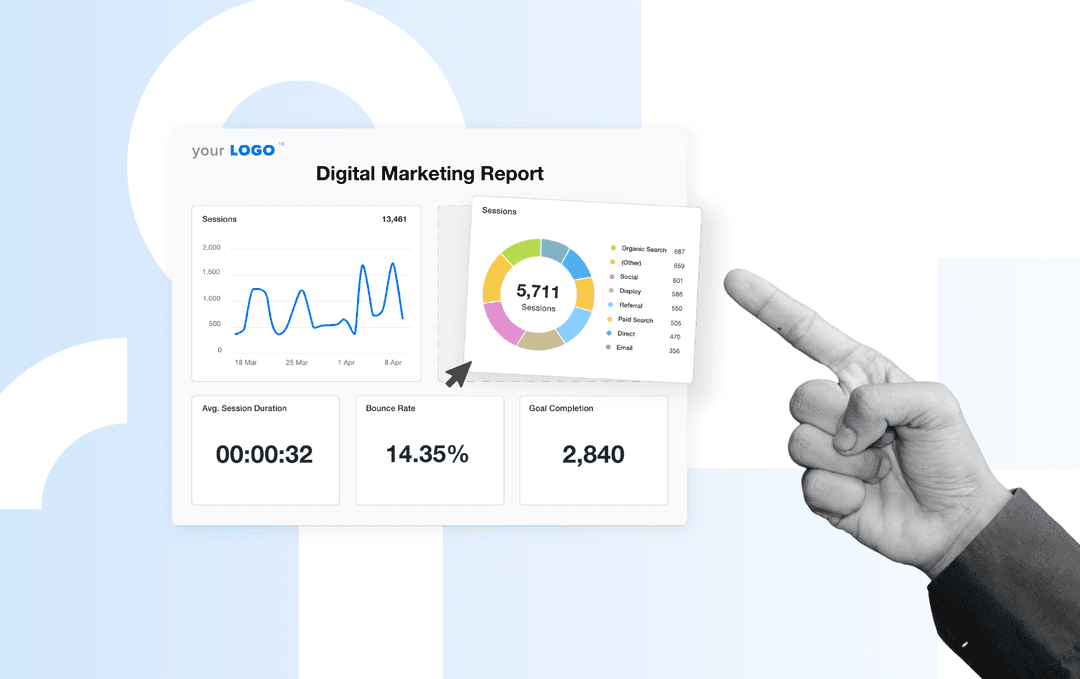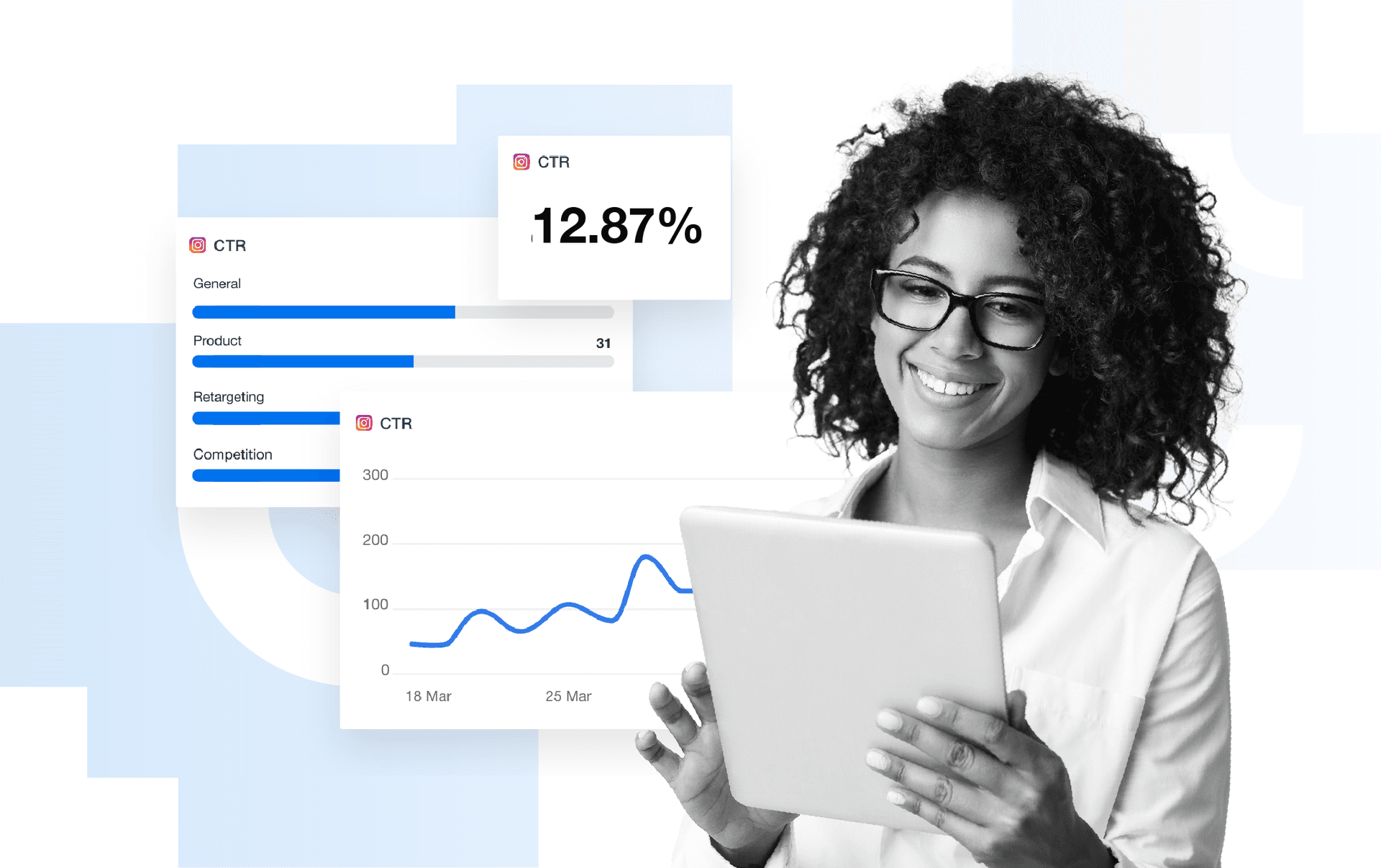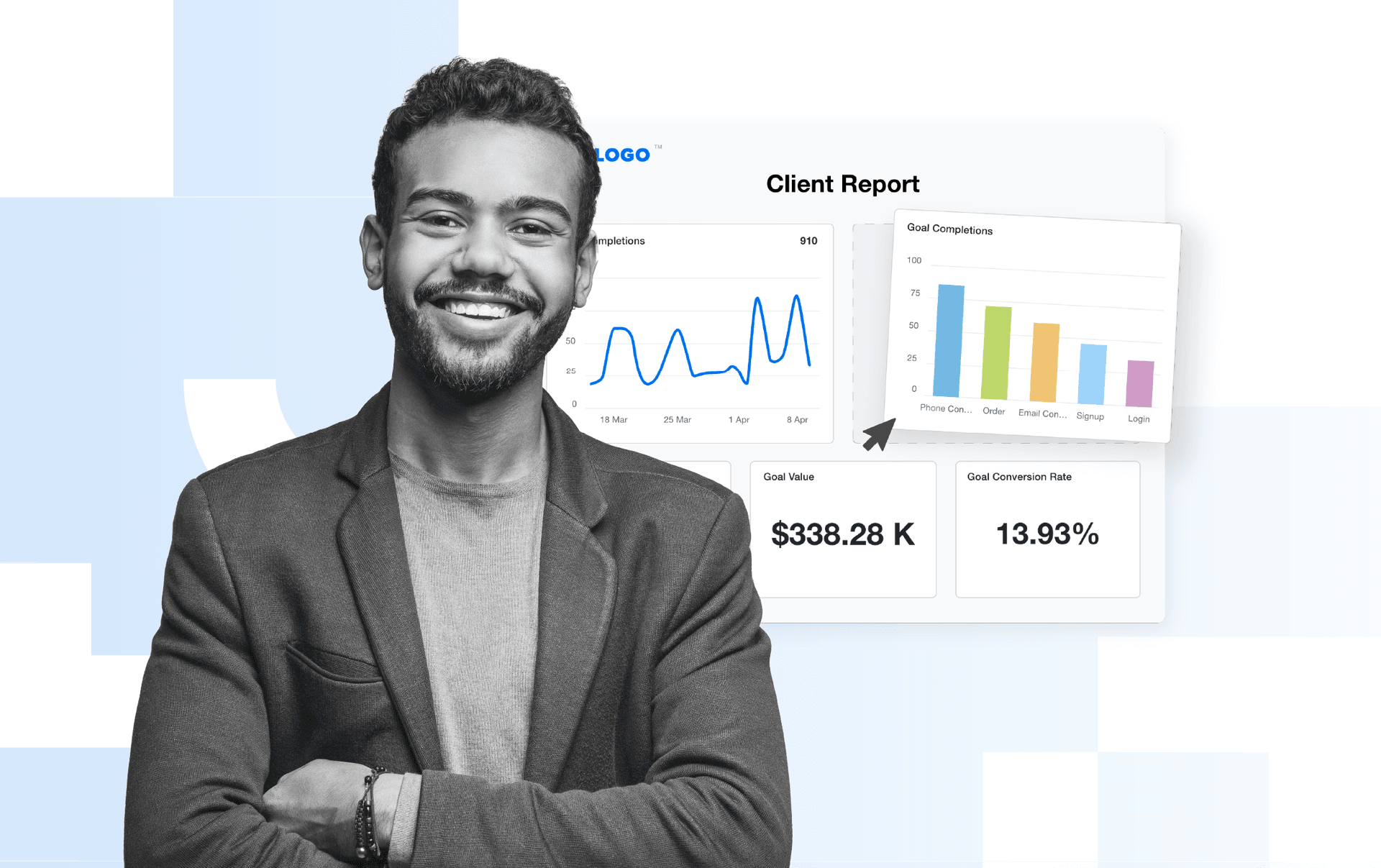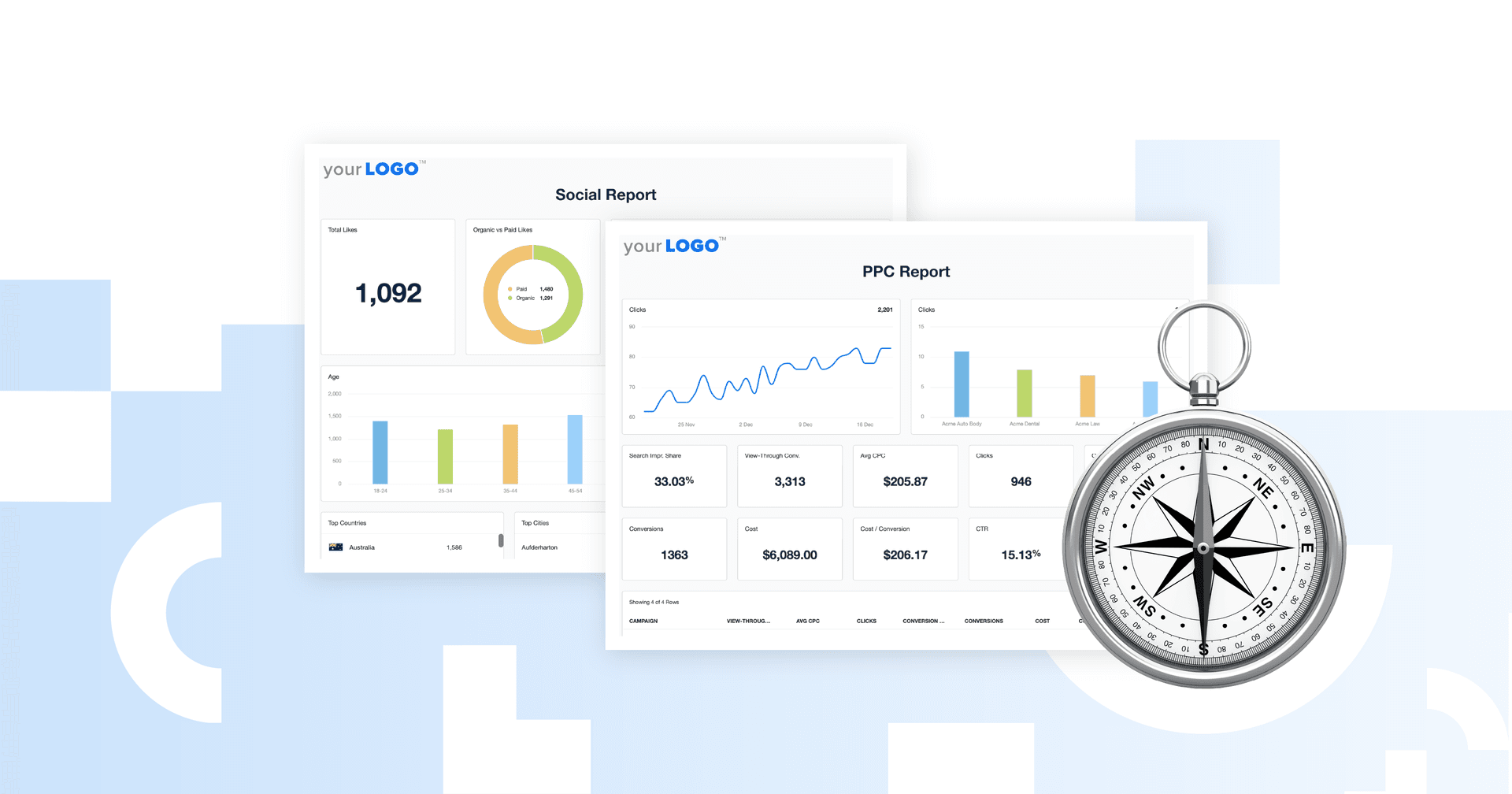Table of Contents
Table of Contents
- Know what they care about—revenue & ROI
- Don’t just show data—tell a simple story
- Cut the jargon. Keep the clarity.
- Use custom dashboards to focus attention
- Avoid vanity metrics that confuse or mislead
- Use templates, then refine based on feedback
- Tie it all back to business results
- Make it easy to see the win
7,000+ agencies have ditched manual reports. You can too.
Free 14-Day TrialQUICK SUMMARY:
Client reports for non-marketers translate marketing data into clear, outcome-focused insights. These reports avoid jargon and emphasize tangible business results—like calls, bookings, or leads. This article shows how to create reports that build trust, highlight impact, and keep clients engaged, even when they aren’t fluent in marketing metrics or terminology.
You know the client. They're brilliant at what they do—maybe they run a dental practice, a legal firm, or a home renovation company. They’ve built their reputation through skill, not CTRs and bounce rates. So their eyes glaze over when they open a marketing report full of charts, acronyms, and traffic trends.
Many agencies lose clients in this situation, not because the work isn’t effective, but because the value isn’t clear.
A great client report goes beyond listing what happened. It highlights what your client cares about—more calls, more bookings, or clearer insight into what’s driving revenue.
There is a lot of data available, but clients are busy, juggling many things, and often don't understand the jargon or technicalities of the digital marketing world. Make reports clear and to the point so they can easily see how you're unquestionably helping their bottom line.
Brendan Chard, Owner, The Modern Firm, LLC
The good news? You don’t have to oversimplify or hide your strategy. You just need to translate it into business outcomes—then build trust by consistently reporting on progress.
Know what they care about—revenue & ROI
It’s easy to fall into the habit of reporting on everything you did: blogs or social media posts, backlinks gained, and new ad copy tested. You might even see major wins in traffic, rankings, or click-through rates. However, the report misses the mark if none of those are tied to what your client actually values.
Most clients—especially those who aren’t marketers—aren’t looking to understand how SEO works or what CPC fluctuation means. They’re running a business. They want to know if their phone is ringing more. If more people are booking consultations. If their revenue is growing.
Report on what your client wants to see, not what you sell. We sell SEO and PPC services—our clients don't care about how they work, they care about calls and their bottom line. I can show them beautiful numbers, traffic patterns, increase in rankings, etc. But at the end of the day, they're paying us for a service to increase their revenue. Ruben Roel, President, Investigator Marketing
This is especially true for clients who don’t understand marketing and don’t have the time—or desire—to learn.
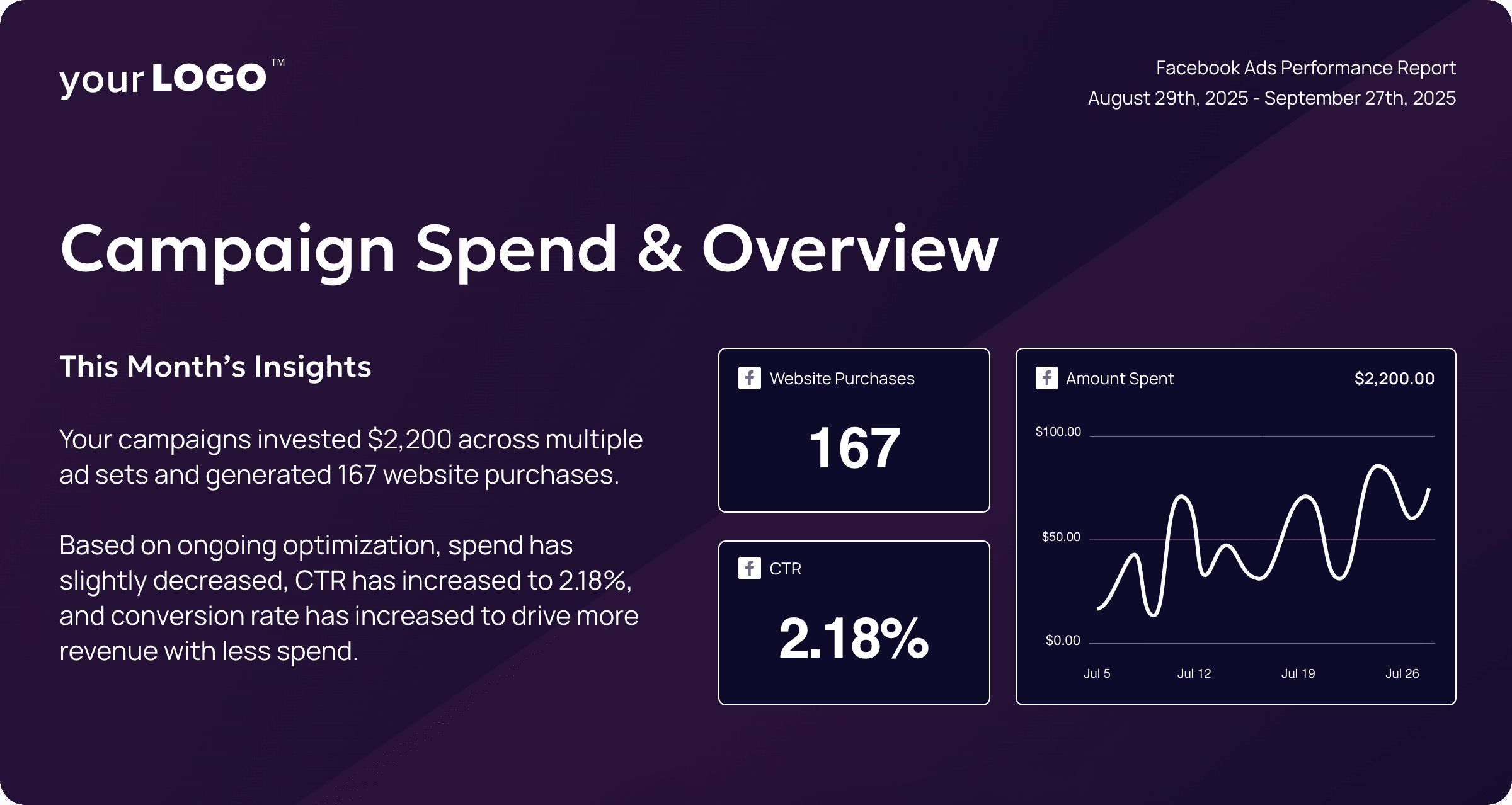
Giving them a report full of secondary metrics may leave them feeling confused or even skeptical. But showing a clear connection between your work and their business goals? That’s what builds long-term trust.
At the end of the day, marketing is still an expense. Our job is to show our clients that their "investment" is actually generating revenue to cover their expense and more.
Ruben Roel, President, Investigator Marketing
The key is simple: report on the outcomes your clients care about—even if they’re not the most sophisticated metrics.
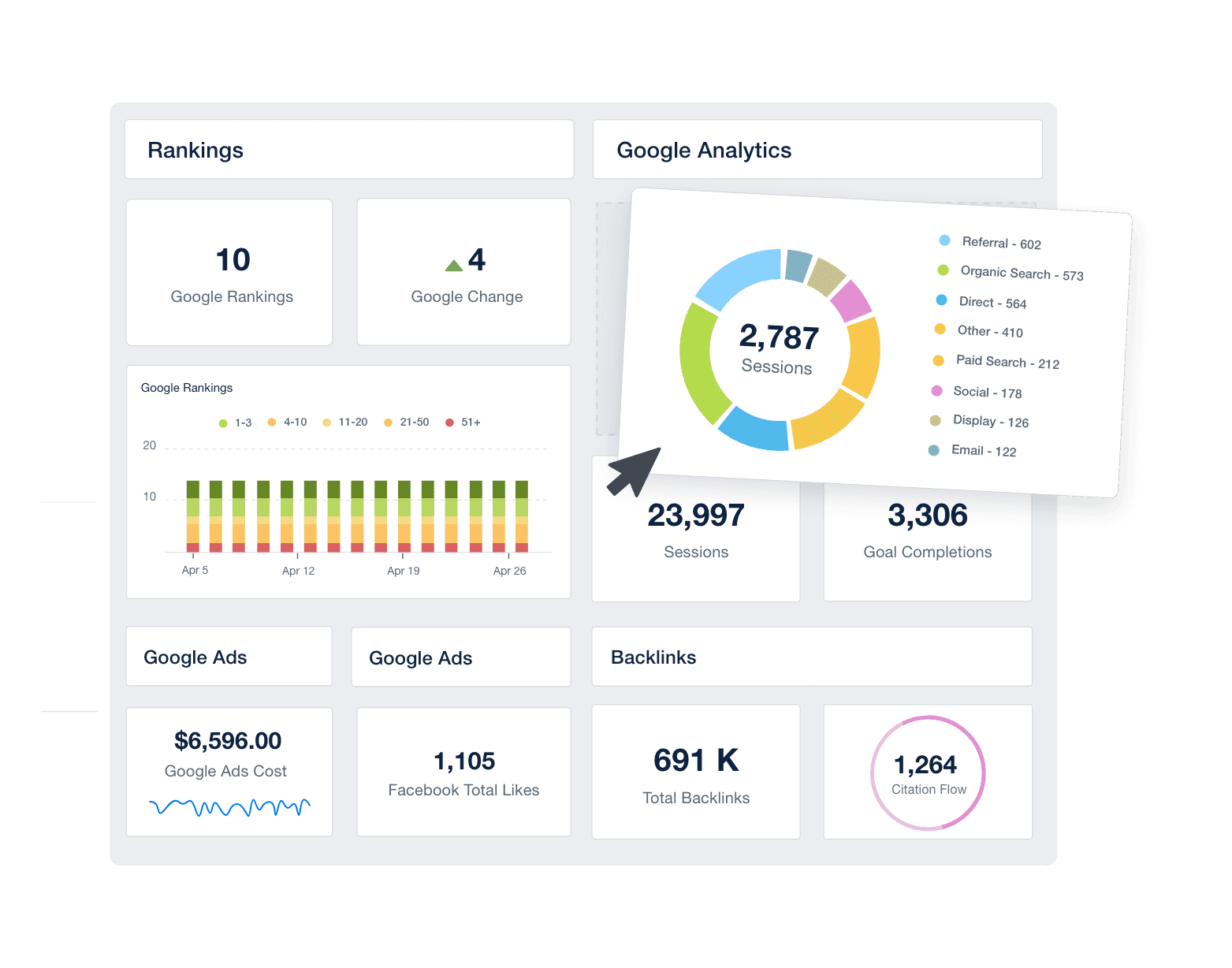
Calls, form fills, bookings, revenue—if that’s how your client measures success, make those front and center.
Don’t just show data—tell a simple story
To you, when you make a marketing report, it's a snapshot of performance. To your client, it’s proof. Proof that their investment is working. Proof that you’re paying attention. And, ultimately, proof that your agency is helping their business grow.
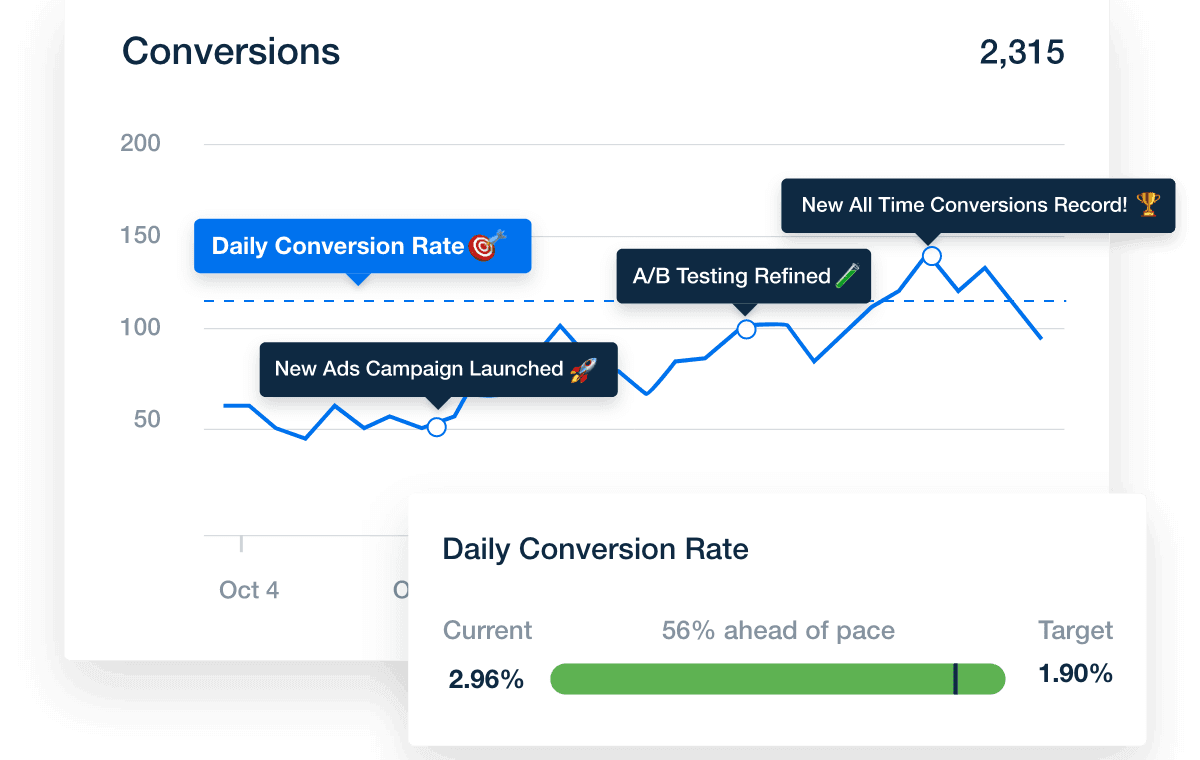
That’s why a great report does more than show numbers. It tells a story. A story with a beginning (where they started), a middle (what changed), and a direction (where things are going). No jargon, no filler—just clear, meaningful insights they can understand at a glance.
It’s our job to tell a simple story through reporting to our clients. The report is the client proof that what we are doing is benefiting their business in a positive way. Using AgencyAnalytics allows us to quickly create beautiful reports that tell a story in a way our client can understand.
Brian Ferritto, Partner, 42connect
This storytelling mindset also helps with retention. Clients don’t just see “numbers went up.” They see momentum—a reason to keep going and to keep working with you.
Ultimately, the key to demonstrating the success of your PPC campaigns is to provide clear and transparent reporting that shows how your services are directly contributing to your clients' business objectives.
Justin Hoffman, Marketing & Sales, Web Solutions Firm
Don’t let reports become a monthly data dump. Use them to show how your work is making a difference—and where the next big opportunity lies.
Cut the jargon. Keep the clarity.
Clients don’t need buzzwords or abstract metrics—they need clarity. And the fastest way to lose that clarity is by leaning on marketing lingo or overcomplicating simple results.
Phrases like bounce rate, CTR, or session duration may be second nature to you, but they can feel like a foreign language to your client.
Some clients want to learn. For them, a light layer of education helps build confidence and deepen the relationship. A simple glossary included in your report template helps clear away some of the confusion.
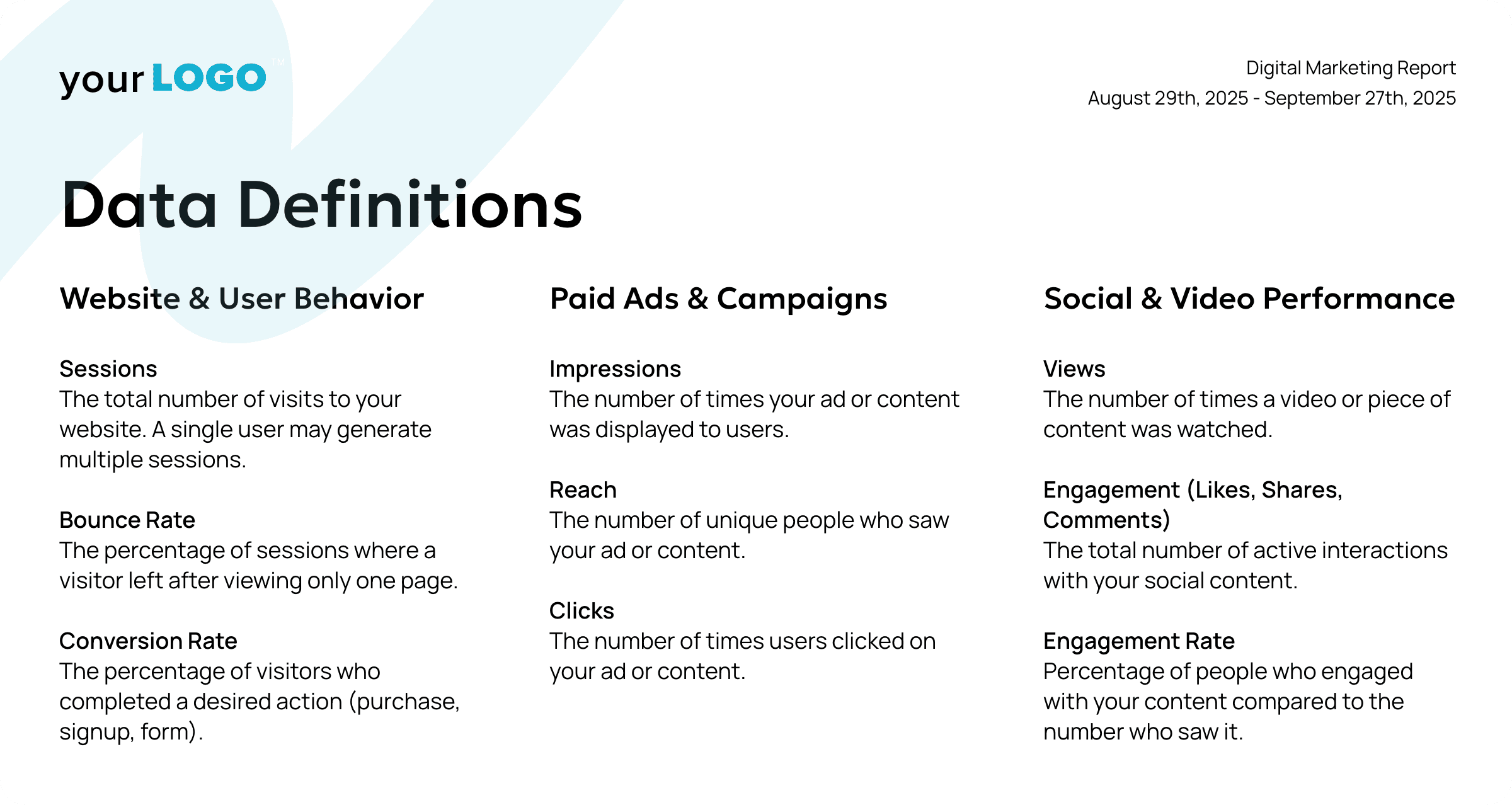
This might also mean walking clients through a report and explaining what a “conversion rate” means in real-world terms—not to show off but to give them the context they need to make informed decisions.
Walk them through the first report! Especially if you are working with contacts who don’t have a marketing background. We might know what CPC, CPM, etc., means, but they perhaps don’t. Tell them why you picked specific subjects to show on their monthly report and what numbers are ‘good’ or ‘bad’. This way, you show them the value of the report and you’ll see higher open rates. This also decreases the amount of questions your agency receives about the reports and increases the overall happiness of your customers.
Nico de Jong, CEO, Forward Marketing
Others don’t want the terminology—they want the takeaway. For these clients, translating marketing data into plain business language is key. Skip the acronyms and surface the insights: more calls, better leads, higher return on ad spend.
There’s no one-size-fits-all approach. But whether you’re teaching or translating, the goal is the same: help your clients clearly understand the value of your work—without making them feel overwhelmed, patronized, or lost in the weeds. Show what the numbers mean in plain language. What happened, why it matters, and what they should know.
You’re not dumbing anything down—you’re making your work accessible. And when clients get it, they trust it.
Use custom dashboards to focus attention
You could show your client everything—the bounce rate on a landing page, the CTR of a retargeting ad, the average session duration from mobile. But should you?
More often than not, too much data overwhelms non-marketing clients. They’re busy and trusting you to filter the signal from the noise. Instead of showing them everything, show them what matters most to them.
Clients want to see real-time data and analytics, but they don't understand metrics or look at metrics the same way we do. To us, a conversion from PPC is a call; to a client, a conversion is money in the bank. So, having the ability to show SEO / PPC results, with traffic, next to a revenue number speaks volumes.
Ruben Roel, President, Investigator Marketing
With customizable dashboards and permission settings, streamline reports so clients see only what’s relevant and actionable.
Client permissions help us ensure that they're only seeing what they truly care about and what will help them understand their progress.
Amanda Caven, Digital Marketing Strategist, Vivid Image
That might mean surfacing top-level results like the number of calls, new leads, or ROI metrics while keeping deeper data available if they ever want to dig in.
We have a diverse roster of clients with different marketing goals and KPIs that they prioritize. Customizable dashboards and report templates allow our team to deliver the metrics and data that our clients care about and that give them the best understanding of the success of their campaigns while ensuring all data is still at their fingertips.
Paul Echols, Creative Director & Agency Owner, Square 205
Clean, focused dashboards make it easier for clients to understand results. But more importantly, they reflect your priorities as an agency. They show that you’re paying attention to what matters to them—not just presenting data that makes your work look good.
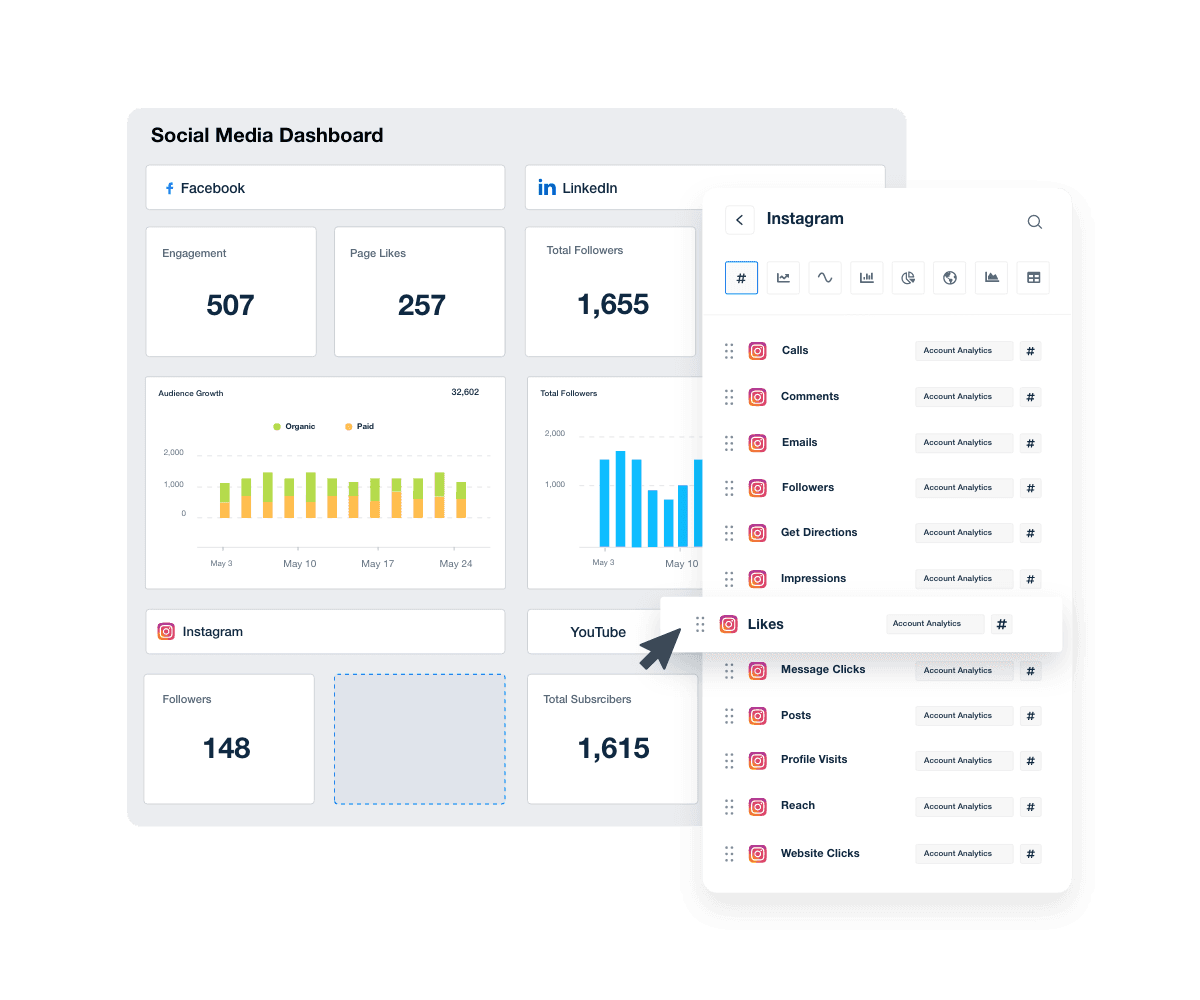
Impress clients and save hours with custom, automated reporting.
Join 7,000+ agencies that create reports in under 30 minutes per client using AgencyAnalytics. Get started for free. No credit card required.
Avoid vanity metrics that confuse or mislead
When clients see a stat in a report, they assume it matters. But not every metric is worth their time—or yours.
Vanity metrics like impressions, pageviews, or social post views often look impressive at a glance, but don’t tell the full story. Worse, they can lead to confusion or misplaced priorities if they aren’t tied to tangible business outcomes.
Vanity metrics can alarm and confuse a client. They think if you're reporting it, then it must be useful—but it can lead to you spending time on activities which have little or no value to the campaign's overall performance.
Paul Morris, Managing Director, Superb Digital
If a metric doesn’t reflect the client’s vision of success, it’s likely clutter, and clutter leads to doubt. The goal isn’t to impress with volume—it’s to focus on clarity. What happened? Why? And what should be done next?
Find out what the client cares about the most and show them that information. Clients don't need to be given data they don't understand, EVEN if it makes you look good. Give them only what they want.
Rebecca Pena, Marketing Director, Investigator Marketing
Effective reporting trims away what’s unnecessary—so what matters is easier to see.
Use templates, then refine based on feedback
Starting from scratch every month is a time sink—and a consistency killer. Report templates save time, create structure, and reduce the risk of forgetting key metrics.
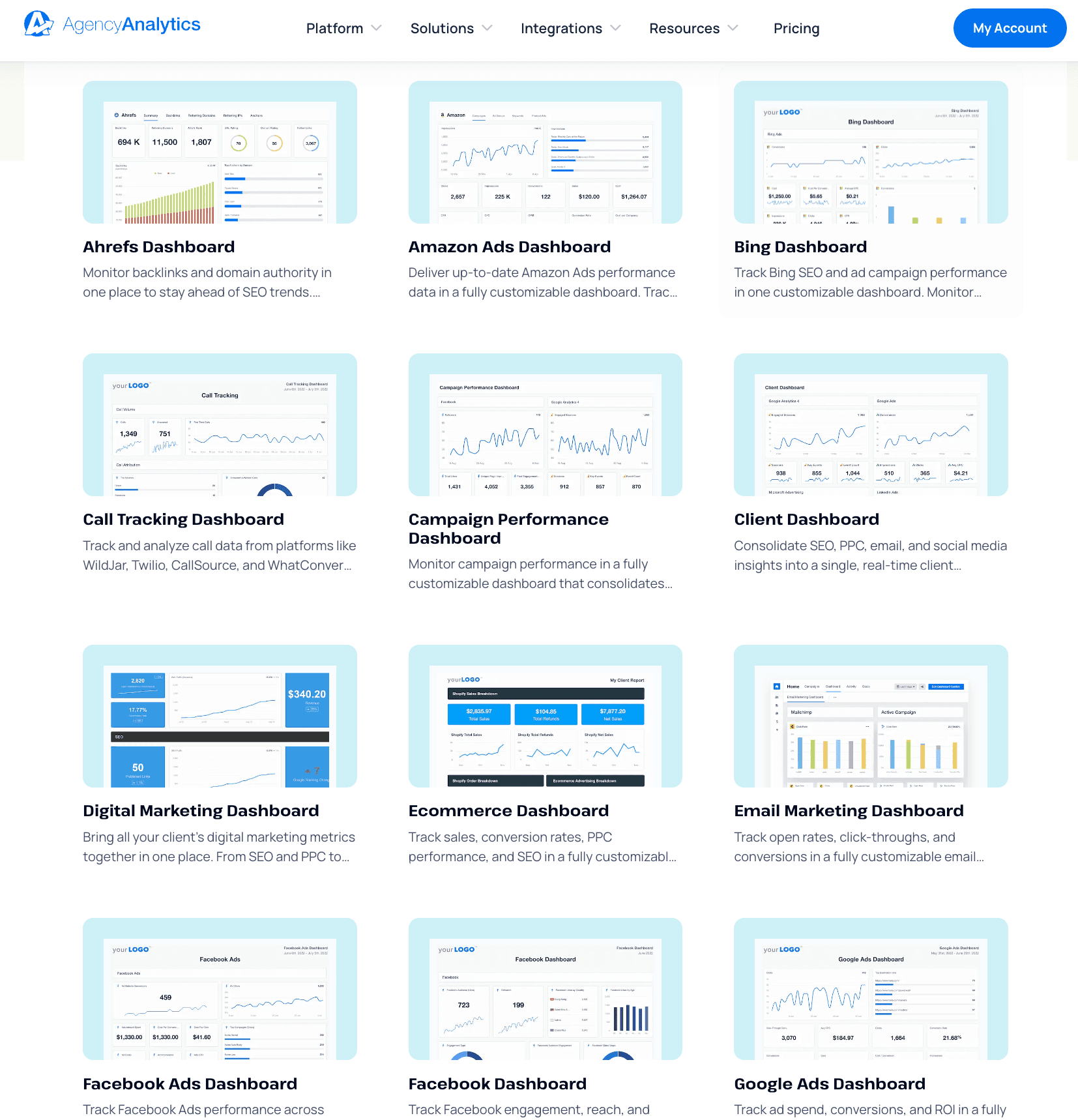
But they’re just a starting point. The real value comes when you use templates as a foundation and build on them based on what your client actually wants to see.
Start from one of AgencyAnalytics' fantastic report templates and modify based upon the KPIs that you or your client care about. Then, keep asking for feedback. The more you understand what your client cares about and how they're measuring success, the better you're able to present focused and engaging data.
Paul Echols, Creative Director & Agency Owner, Square 205
Whether it’s a new campaign or shifting business priorities, reporting should evolve over time. Asking for feedback not only improves the reports, but it also shows your clients that their input matters.
Our clients are busy and don't understand marketing, so having key metrics they can agree have a relationship to business growth is key to making their lives easier and allows them to make good decisions quickly.
Lane Rizzardini, Co-Owner, Marion Relationship Marketing
Templates give you the framework. Your clients will help you shape the story.
Tie it all back to business results
No matter how sophisticated your strategy, clients judge success through a simple lens: Is this helping my business grow?
That’s why every report should connect your work to measurable business outcomes.
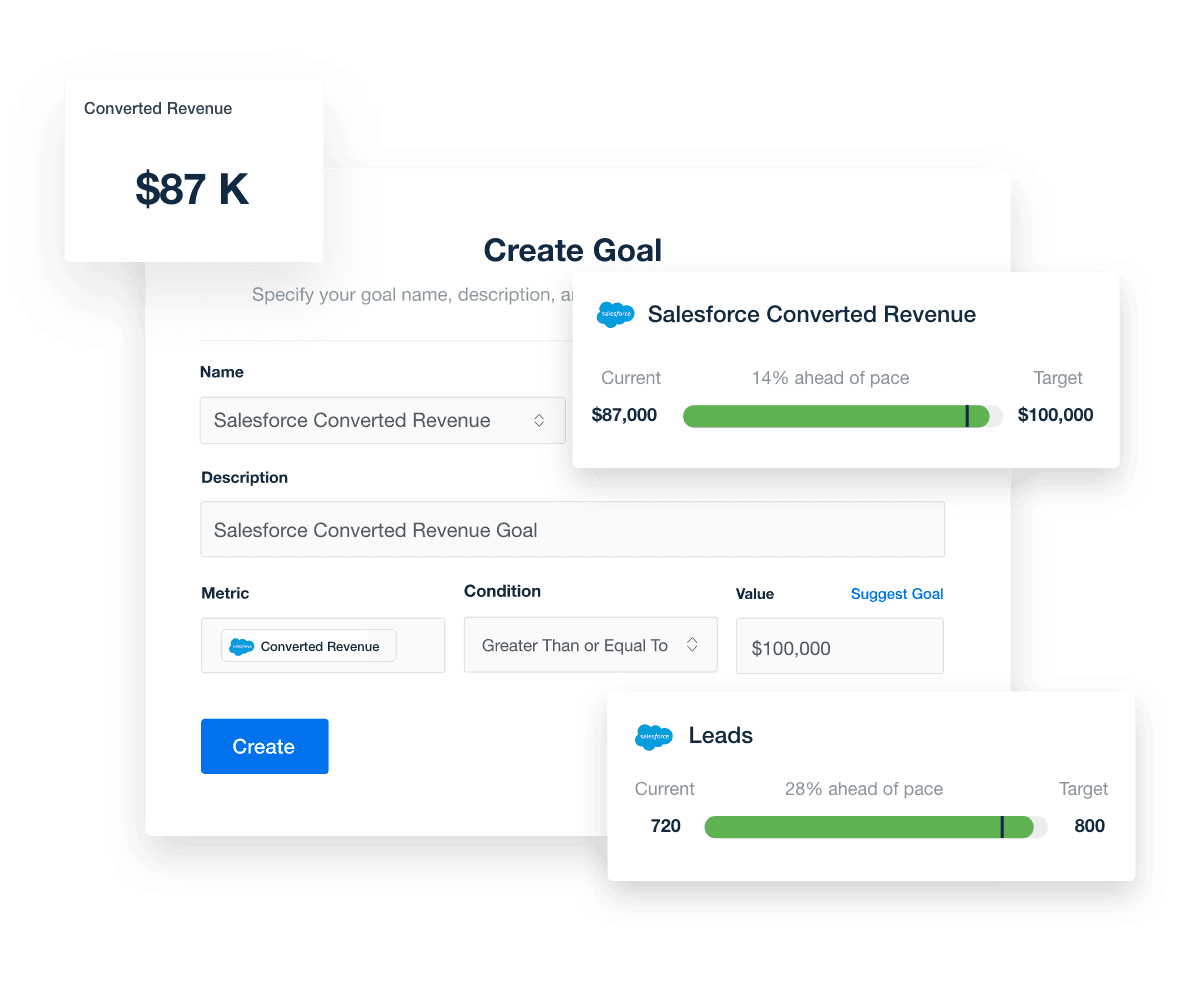
Whether that’s increased revenue, more qualified leads, or consistent monthly calls—your reports should show the “why it matters” behind every data point.
Don't forget that an observation is not an insight. Clients don't pay for observations, they pay for someone with a deeper understanding of the data to share what the data means, why it's important, and what they should do about it.
Kerrie Luginbill, Chief Strategy Officer & Partner, OTM
That shift in perspective matters. A report full of technical success doesn’t mean much unless the client sees how it impacts their day-to-day business. That’s why it’s worth asking: if I were the client, what would I want to know right now?
Client reporting is the backbone of our relationship with clients. Informative reporting builds trust with clients' internal management and marketing teams, letting them know that data is accurate, useful, and can be broken down in an easy-to-understand and customized layout.
Paul Echols, Creative Director & Agency Owner, Square 205
Clear, relevant reporting helps clients make decisions faster—and with more confidence. And that’s how you shift from being a monthly expense to becoming a trusted partner.
Make it easy to see the win
Your client is busy. They’re juggling team meetings, budgets, customer issues—and now, your report is sitting in their inbox. If it takes more than a few seconds to figure out what’s working (or not), they’ll either skim it… or ignore it altogether.
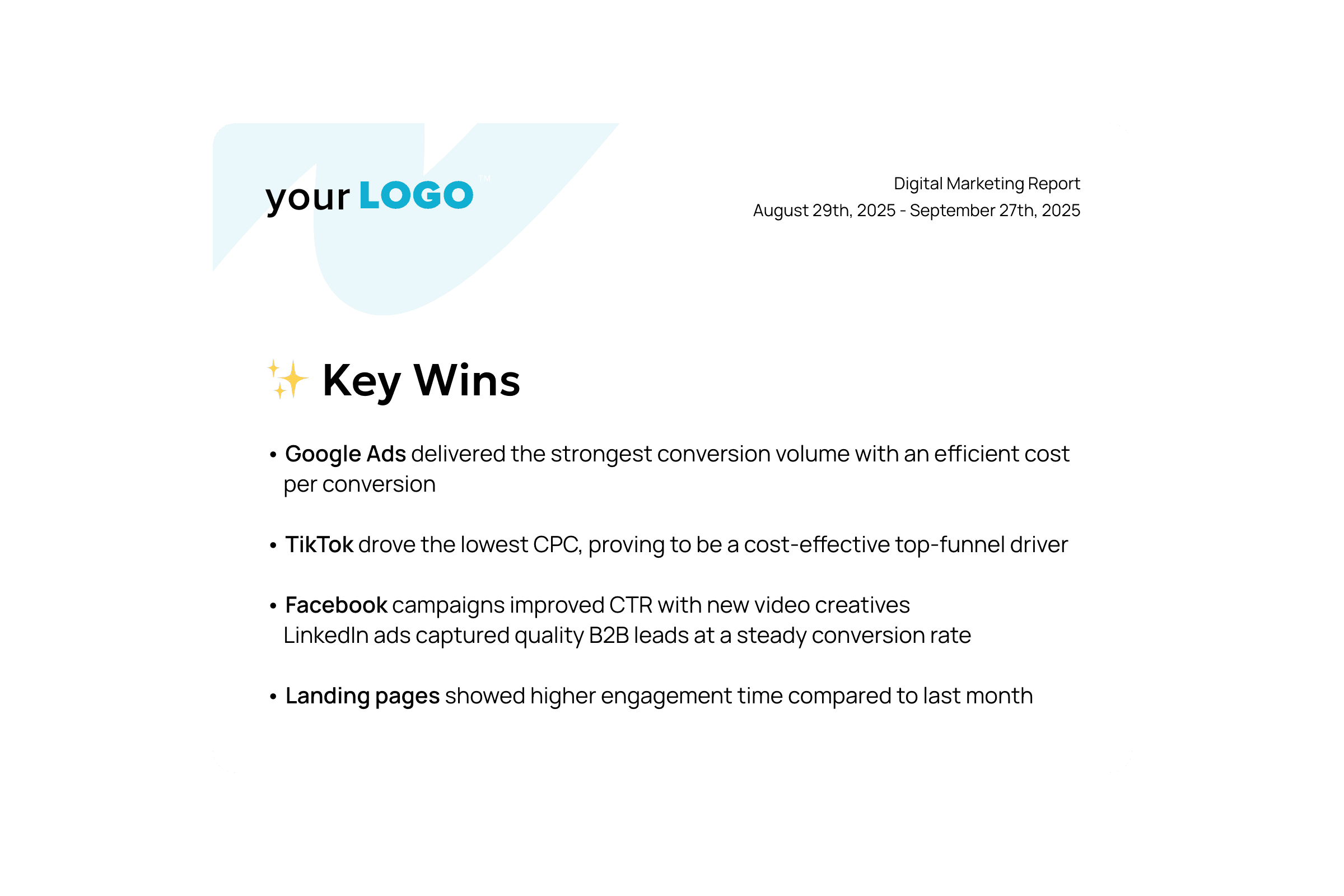
Good reporting goes beyond summarizing data. It highlights the real wins your client cares about. It should be easy for clients to spot what has improved, understand why it matters, and feel confident that their investment is paying off.
Don’t just show the metrics, show the WHY behind the metrics. Explain why it is important that we look at specific numbers each month and what they mean for the overall health of their marketing and growth of their company. Jessica Weiss, Director of Marketing & Strategic Partnerships, One Firefly
This doesn’t mean hiding anything. It means presenting information in a way that’s structured, purposeful, and centered on what the client truly cares about. When you cut through the noise and speak directly to their goals, it builds trust—and that trust keeps clients around.
Accurate reporting is a great way to show customers that the work you are doing is making a difference. It also provides a huge benefit when all of the marketing data is centralized into one report.
Justin Hoffman, Marketing & Sales, Web Solutions Firm
So before you hit “send” on that next report, ask yourself: can the client see the win? If the answer is yes, you’re giving them exactly what they need to move forward—with clarity, confidence, and a clear sense of progress.

Written by
Paul Stainton is a digital marketing leader with extensive experience creating brand value through digital transformation, eCommerce strategies, brand strategy, and go-to-market execution.
Read more posts by Paul StaintonSee how 7,000+ marketing agencies help clients win
Free 14-day trial. No credit card required.



